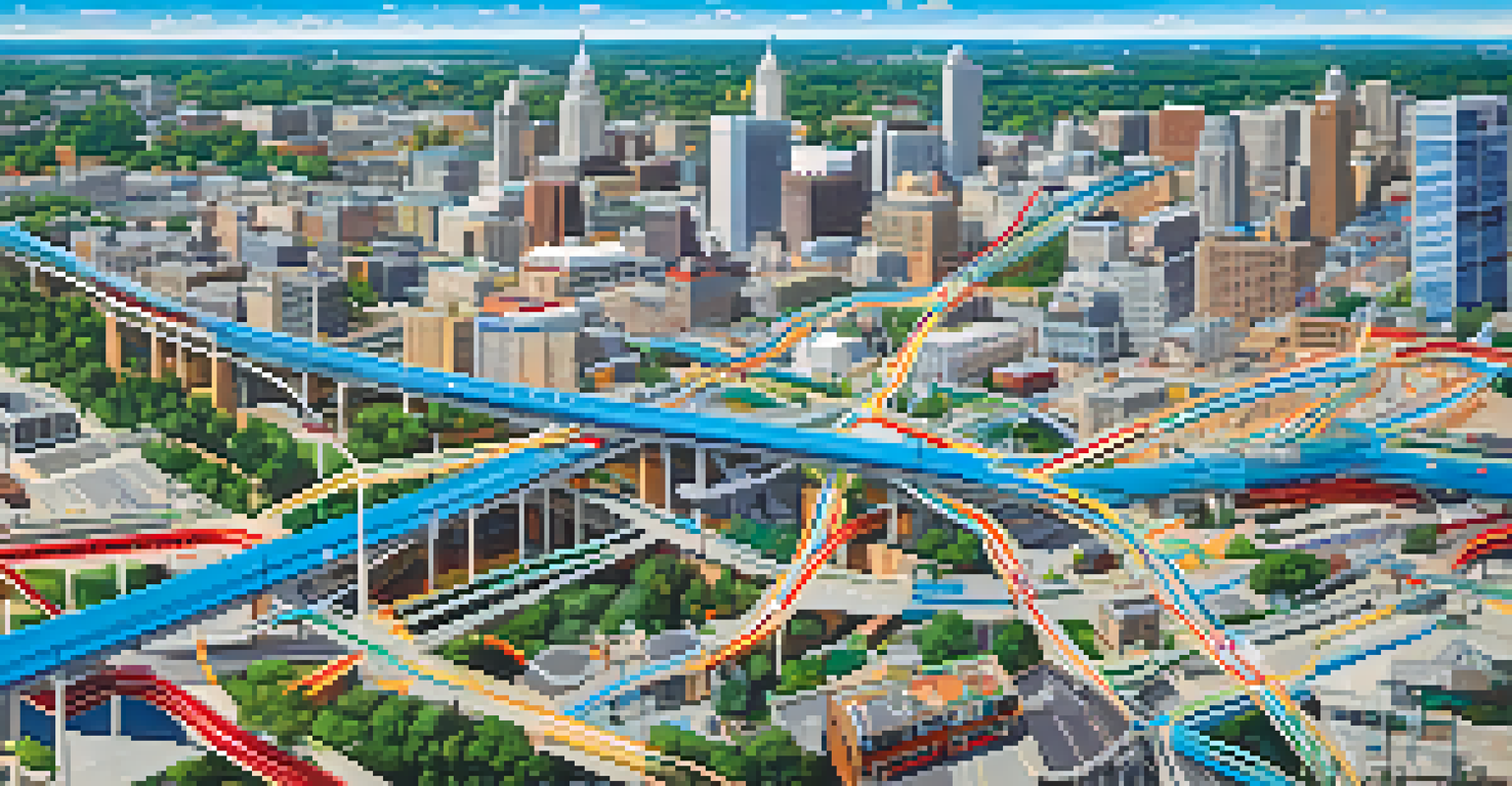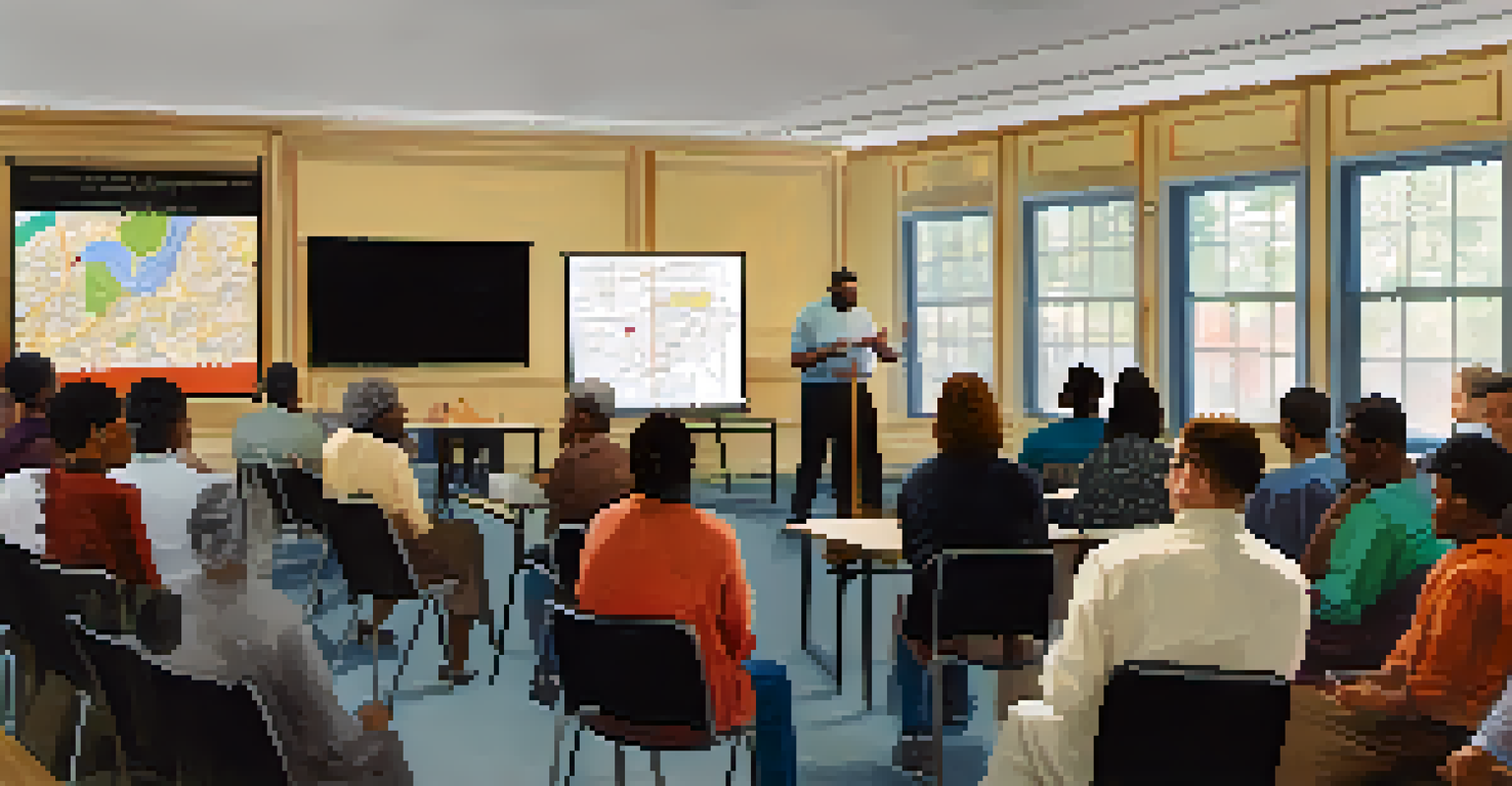Exploring Raleigh's Public Transit: Current Systems and Challenges

Overview of Raleigh's Public Transit Landscape
Raleigh, the capital of North Carolina, boasts a growing public transit system aimed at enhancing urban mobility. The primary service provider, GoRaleigh, operates a network of bus routes connecting key areas of the city. As the city expands, so does the need for efficient transportation options, making public transit a crucial component of urban planning.
Public transportation is a crucial component of urban planning, as it enhances mobility and reduces congestion.
In addition to GoRaleigh, the city also benefits from complementary services like GoTriangle and GoCary, which extend transit access to neighboring regions. These services collectively aim to reduce congestion and promote eco-friendliness by encouraging the use of public transport over personal vehicles. Understanding the current systems is key to recognizing their impact on daily commutes and overall city dynamics.
Despite the existing framework, Raleigh's public transit system has room for growth. As more residents seek sustainable commuting options, the challenge lies in accommodating the increasing demand while ensuring service reliability and coverage.
Current Systems: GoRaleigh and Beyond
GoRaleigh operates numerous routes that cater to various neighborhoods and commercial areas, providing residents with accessible transportation. The service includes standard buses, as well as express routes aimed at commuters traveling to downtown and business hubs. With a focus on convenience, GoRaleigh has introduced features such as real-time tracking and mobile ticketing to enhance the user experience.

In tandem with GoRaleigh, GoTriangle offers vital connections to surrounding counties, making it easier for residents to access jobs, education, and entertainment both locally and regionally. This interconnectivity is essential for a comprehensive public transit system, allowing seamless travel for users needing to navigate beyond Raleigh’s borders. The collaboration among these services reflects a collective effort to enhance mobility in the Triangle area.
Raleigh's Transit Needs Expansion
Raleigh's public transit system requires growth to accommodate increasing demand and ensure service reliability.
However, the systems are not without their challenges. Issues such as limited service frequency, especially during off-peak hours, can deter potential riders from opting for public transit over personal vehicles. Addressing these concerns while expanding service coverage remains a priority for city planners.
Benefits of Using Public Transit in Raleigh
One of the most significant benefits of using public transit is its positive impact on the environment. By reducing the number of cars on the road, public transit helps to decrease greenhouse gas emissions and air pollution. This aligns with Raleigh's sustainability goals and promotes a healthier urban environment for all residents.
Investing in public transit is investing in the future of our cities and the quality of life for our residents.
Additionally, public transit can save riders money. Owning and maintaining a vehicle can be expensive, with costs associated with fuel, insurance, and repairs. By utilizing public transport, residents can allocate their finances towards other essential needs, making it an economically viable option for many.
Public transit also fosters community engagement. By providing accessible transportation, it encourages individuals to explore different neighborhoods, attend events, and participate in local activities. This not only enriches the lives of residents but also strengthens community ties across Raleigh.
Challenges Facing Raleigh's Public Transit System
Despite the benefits, Raleigh's public transit system faces several challenges that hinder its effectiveness. One major issue is the limited coverage area, which does not adequately serve all neighborhoods, particularly those further from the city center. This can lead to a reliance on personal vehicles for many residents, counteracting the goals of public transit advocates.
Another challenge is the frequency of service. Buses that run infrequently, especially during evenings and weekends, can make it difficult for individuals to rely on public transit for their daily commutes. This inconsistency can discourage potential riders, leading to lower overall ridership and reduced funding for future improvements.
Environmental and Economic Benefits
Using public transit in Raleigh can reduce emissions and save residents money on transportation costs.
Lastly, there is ongoing competition for funding and resources. Public transit systems often compete with other city projects for budget allocations, making it challenging to secure the necessary investment for upgrades and expansions. Addressing these challenges is crucial for the long-term sustainability and growth of Raleigh's public transit.
Public Perception of Raleigh's Transit Systems
Public perception plays a significant role in the success of any transit system, and Raleigh is no exception. Many residents appreciate the convenience of public transportation but express concerns about reliability and coverage. Surveys indicate that while there is a desire for improved services, there is also a general skepticism regarding the current systems' ability to meet those needs.
Moreover, experiences with public transit can vary widely among users. Some individuals have positive stories about their daily commutes, while others recount frustrating delays or overcrowded buses. These mixed experiences affect how likely residents are to recommend public transit to newcomers or visitors, influencing the overall perception of the system.
To improve public perception, city officials must actively engage with the community, seeking feedback and making necessary adjustments based on rider experiences. This dialogue can help build trust and encourage more residents to consider public transit as a viable option.
Future Development Plans for Public Transit
Looking ahead, Raleigh has ambitious plans for enhancing its public transit system. City officials and planners are exploring options for expanding bus routes and increasing service frequency to better serve underserved areas. These improvements are essential for fostering a more inclusive transit system that meets the diverse needs of Raleigh’s growing population.
Additionally, the development of light rail systems is on the table, which could provide a faster and more efficient mode of transportation for commuters. Light rail has been successful in other cities, reducing travel times and attracting more riders. Such initiatives could significantly alter the transit landscape in Raleigh, making it a more attractive option for residents.
Community Involvement is Essential
Active participation from residents in transit planning can lead to more effective solutions and improved public perception.
Community engagement will be crucial in this development process. Ensuring that residents have a voice in planning discussions will help create a transit system that reflects the needs and preferences of the community. This collaborative approach can lead to a more successful and widely accepted public transit system in Raleigh.
How Residents Can Get Involved in Transit Planning
Residents have a unique opportunity to shape the future of Raleigh's public transit by actively participating in planning discussions and community forums. Engaging with local government initiatives can provide valuable insights into the needs and preferences of the community. This grassroots involvement can lead to more tailored solutions that address specific challenges faced by riders.
Additionally, residents can contribute feedback through surveys and public meetings, which help transit authorities understand where improvements are needed most. Sharing personal experiences and suggestions can influence decision-making processes, ultimately leading to a more effective public transit system. This collaborative effort can bridge gaps between officials and the community.

Lastly, advocating for public transit can extend beyond just participation in meetings. Residents can promote awareness of transit options among friends and family, encouraging more people to utilize public transportation. This advocacy can help shift public perception and increase ridership, making a compelling case for further investment and improvements in Raleigh’s transit systems.